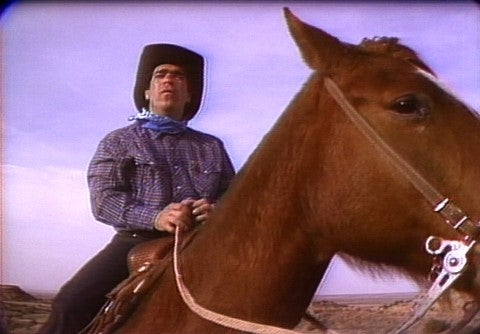Only a few years after Chicago-born artist Michael Smith graduated from Colorado College in 1973 with a degree in painting, his practice took a significant turn. Rather than switching from oil to acrylic paint or moving from abstraction to figuration, Smith abandoned his brushes and canvas and ventured into the then-nascent genre of performance art. Since his first pieces—such as Down in the Rec Room (1979) and USA Freestyle Disco Championship (1979)—debuted his acclaimed persona “Mike,” performances have been featured internationally in solo and group exhibitions at the Whitney Museum of American Art, Tate Modern, Sculpture Center, ICA Philadelphia, New Museum of Contemporary Art, Baltic Centre for Contemporary Art, Museo Jumex, and the Blanton Museum at The University of Texas at Austin, where he has been a professor since 2001.
Smith’s early influences include deadpan comedians like Jackie Vernon; mid-twentieth-century kids’ shows; and naïve, befuddled characters such as Jacques Tati and Buster Keaton. His first character, Baby Ikki, is an oversized, eighteen-month-old infant, whom he has continued to play for more than forty years. Wearing a diaper and bonnet and sucking on a pacifier, the easily distracted baby has wandered through a range of scenarios, from reveling at his own birthday party (Baby Ikki's Birthday Party, 2008) to wandering unattended at the Burning Man festival in Nevada’s Black Rock Desert (A Voyage of Growth and Discovery, 2010). Baby Ikki has been called “an archetype with an unclear mission, onto which spectators project their own interpretations.”
A similar description could also be applied to Smith’s celebrated persona “Mike,” another blank slate. The dull, ordinary, but nonetheless confident and optimistic guy who “believes everything and follows anything,” was developed by the artist in the late 1970s. Smith explained, “A lot of people seem to empathize with Mike. . . . I think of him as a kind of Everyman. . . . He is 30 going on 50 and very middle class.” Smith’s first video featuring Mike was Secret Horror (1980). In it the character experiences a nightmare in which he encounters ghosts who invade his home and transport him to a TV game show. The video includes a variety of popular cultural references, such as songs by Neil Diamond and The Kingston Trio as well as the snack Bridge Mix, thus mining the “collective cultural unconscious of trashy sitcoms, pop songs and brand names.”
Smith’s fascination with and investigation into the impact of TV and pop culture continued in Go For It, Mike (1984), which takes it cues from the music video format of then-thriving MTV, while offering trenchant commentary on the social and political inequities of the American Dream. Set to a pop-rock melody, it begins with shots of Smith’s Pinto driving across town to a university, where Smith and a back-up chorus dance and sing the lyrics of “Go For It, Mike.” The song describes the personality of Mike, a man who “looks to the future and doesn’t ask why.” Dressed in prep-school style with a “MIKE” belt buckle, he takes in history lessons on Manifest Destiny, extolling its virtues, along with the mantra, “Some people are born to win [and] some people are born to lose.”
The artist mocks this idea and type of person who subscribes to it, as he simulates riding horseback on a carousel and conducting a train that remains stationary. Despite the incompetence of Mike, he fails upward. Ascending in society, politics, and business, he gives whistlestop tours and oversees housing development plans, suggesting a tragic inevitability of his success.
The artist Smith recounted, “In the 80s I reacted to Reaganomics. It was hard for me to accept the Reagan message as sincere. I always projected a cynicism onto it. So, in a way, I was just representing what they were serving up to the American population.” Amid the fervor of the video’s song and dance routine, Smith’s droll expressions convey an emptiness in his gestures and pursuits. The video accordingly ends with a nod toward the insincerity and especially the banality of power, when Smith looks to the distance and feebly states, “Maybe I’ll go for it.” —Kanitra Fletcher

